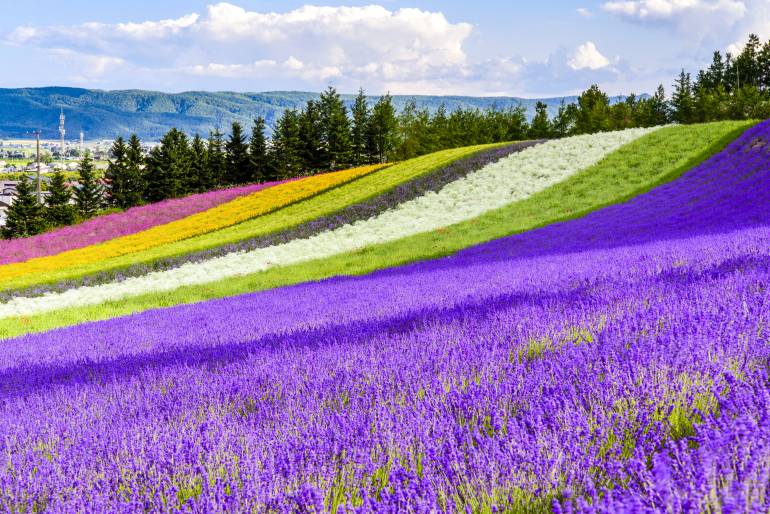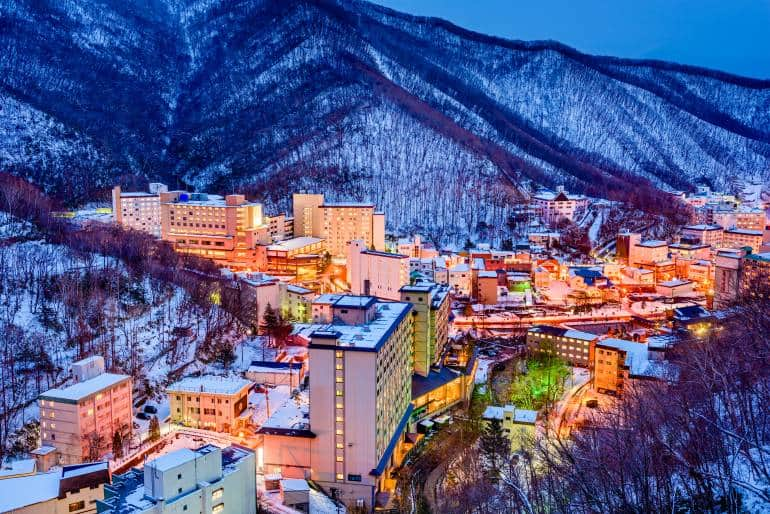What makes Japan so amazing to travel in is the variety—with every new prefecture, city or village you find something unique. Consisting of 47 prefectures, including 43 traditional prefectures, two urban prefectures (Osaka and Kyoto), one territory (Hokkaido) and the Metropolis of Tokyo, Japan has a lot of ground to cover, and a lot of surprises to unearth. If you’re thinking of venturing outside of the obvious, here are some highlights to help you pick your prefecture. This article travels up to the northernmost parts of Japan, Hokkaido and Tohoku! If you are after snow, hiking, onsens and amazing festivals—this is the region for you!

Jump to:
Hokkaido – 北海道

It’s own region and technically a territory, Hokkaido is a winter wonderland with famous skiing areas like Niseko, plenty of delicious foods to keep you warm and stunning scenery throughout the year.
Sights
- Noboribetsu: The island’s most famous onsen area, which is surrounded by forests and mountains. It has nine kinds of water and is ranked among the world’s most exceptional hot springs. You can try the benefits of sulfur, salt and iron, as well as visiting Hell Valley, where sulfurous gas seeps from the grounds. There’s also an annual “Naked Man” Festival.
- Furano lavender fields: Covering the landscape in swathes of purple, the lavender farms are free in Hokkaido, with a backdrop of mountain ranges you can enjoy the lovely views at one of the many cafes or on a cart ride.
- Blue Pond: A result of works on the Biei River to protect towns from volcanic mud flows, this pond is a stunning glassy blue and you may recognize it from computer backgrounds around the world.

Festival
The Yuki Matsuri (Snow Festival) is world famous, with giant snow sculptures, ice displays and plenty of performances, it’s a great time to see the island in all its glory.
Food
Hokkaido ramen is the perfect thing to warm you up on a cold day: a tonkotsu base seasoned with soy sauce, salt or miso—each coming from different areas. Hokkaido is also considered the birthplace of miso ramen. Head to Ramen Alley in Sapporo to try the different kinds, butter and corn make a great addition!
Tohoku
Famed for rice and fruit production, onsen, and stunning scenery, Tohoku is a snowy wonderland in winter and a cool escape in summer. With six prefectures, the mountainous terrain is home to active volcanoes, beautiful bays and lively cities with famous festivals and dozens of speciality dishes to try.
Further reading: Our guide to exploring Tohoku from Tokyo.
Aomori – 青森県

The northernmost prefecture on Honshu, Aomori is filled with forests, farming, and fishing—and is famous for apples.
Sights
- Hirosaki Castle: Retaining many of it’s Edo-period features, Hirosaki’s castle was listed as one of Japan’s 100 finest castles and is one of Japan’s most famous cherry blossom spots with over 2600 trees.
- Aomori Showa Daibutsu: The tallest seated Buddha in Japan weighs in at 220 tons and is 70 ft tall. Although it was only built in 1984, it’s a pretty impressive sight nonetheless.
- The Hiraizumi Temples: Numerous Buddhist temples fill this city, with some built as the foundation for a peaceful Buddhism based realm, some built in rockfaces and some believed to be over 1300 years old.
- Genbikei Gorge: To see this stunning natural gorge, you can hop into a “flying dango” (rope basket) and be sent across. Alternatively, you can take a boat to enjoy the views from the water.
- Mount Iwate: Technically active but not considered dangerous, Mt. Iwate is a great hike offering one of the best scenic views in all of Iwate. It has six trails to choose from, but best check with a local tourist center about the activity status just in case!
- Cat Island and Fox Village: A small island an hour away from the mainland by ferry—Tojima has one thing going for it, and it’s cats. Hundreds and hundreds of cats. (It’s not to be confused with Kyushu’s cat island.) If you prefer foxes, head to Zao: this mountain sanctuary has very photogenic foxes living wild. You can see cubs in spring and get much closer than usual!
- Matsushima Bay: With islands and temples alike, this area is famed for it’s stunning bay views and you can enjoy scenic boat tours around the islands.
- Zuihoden Mausoleum: A faithful replica of the 1637 original, this mausoleum complex sits among the trees and is the resting place of the founding daimyo of the Sendai domain.
- Lake Tazawa: Surrounded by onsens perfect for winter, this lake is an amazing getaway and is popular with Japanese visitors from far and wide.
- Kakunodate: A small preserved town with samurai houses, it is likened to a little-Kyoto with a museum dedicated to the author of the first Japanese illustrated guide to anatomy.
- Namahage Folklore Museum: A great place to see the unusual costumes and characters from Japan’s sometimes terrifying folklore of Namahage who encourage hard work in the young, before being given sake and food.
- Ningen Shogi/Human Chess: In late April, you can see a game of human chess (like Harry Potter) with local people dressed in traditional 400-year-old costumes, surrounded by cherry blossom.
- Dewa Sanzan: Three mountains which form a traditional Shinto Pilgrimage, this trail is the oldest history of mountain worship in Japan. It includes a stunning five-story pagoda at the base of Mt. Haguro too.
- Yamadera: Follow a thousand-step climb through dense cedar forests to the temples carved into the mountainside. With amazing views and plenty of treasures within, it’s a rewarding hike to say the least.
- Goshiki Numa: The five colored lakes were created during a volcanic eruption in 1888 and each have their own distinctive hue thanks to the mineral deposits left by Mount Bandai’s eruption. A 4 km walking path allows you see to see all five, which change color throughout the year, ranging from reddish-green to cobalt blue.
- Ouchijuku: A former post town connecting Aizu and Nikko, this town has retained it’s Edo-period charm. Since travelers had to journey on foot by law, these towns provided food and accommodation. There are thatched houses, unpaved roads and traditional inns and restaurants serving local favorites like soba and grilled fish.
- Kitakata: Head to this area for museums and craftwork. And try a bowl of Kitakata ramen, made with sardine and pork-bone broth. Its ramen is one of the top three in Japan, alongside Sapporo and Hakata. There are over 100 ramen shops in town!

Festival
The Nebuta Festival, held in the first week of August, features glowing floats paraded through the city accompanied by dancers chanting the traditional Rassera. One of the three biggest festivals in Tohoku, it is an amazing sight and is believed to originate from the efforts to attract the attention of enemies in battle.
Food
Apples: Aomori is the biggest apple producer in the country; half the country’s apples come from here. You can eat them as nature intended, try them as delicious apple juice or in all sorts of desserts, and even pick them in August!
Iwate – 岩手県

Iwate is home to a thriving onsen scene, stunning beaches, great skiing, and a busy fishing industry. It is famed for its Buddhist temples, and has an active, but very quiet, volcano.
Sights
Festival
Northenmost Ama Festival: Here you can see the female free-divers known as ama catching sea urchin and abalone. You can also try fresh seafood and watch the sea urchin catching contest.
At the Chagu Chagu Umakko, elaborately dressed horses are paraded through the town during rainy season.
Food
Eating wanko soba noodles is like an all-you-can-eat contest. As tradition, the noodles are served in small bowls after a festival ran low once. You can stack up your mini bowls to your stomach’s content, and when you’re done, place a lid on top to signal the waitstaff.
Miyagi – 宮城県

Combining natural beauty with lively cities and festivals, Miyagi has plenty of unusual sights (including Cat Island), amazing onsen towns, great seafood, and a stunning bay area.
Sights

Festival
Sendai Tanabata: This festival is a large-scale celebration of the star festival, with fireworks, decorations and parades all taking place in the green city of Sendai.
Food
Roast cow tongue is a local favorite. Same with oysters—and with plenty of fishing, all seafood is good here!
Akita – 秋田県

Known for rice brewing and sake distilleries, Akita has the highest consumption of the drink. It’s also the home of the popular dog of the same name. Famous for its hot springs and festivals—it’s a year-round destionation prefecture.
Sights

Festival
The Akita Kanto Festival is celebrated in early August and is one of the three main Tohoku festivals. Hoping to bring a good harvest, locals parade 200 bamboo poles with either 24 or 46 lanterns topped with gohei.
For things more terrifying, catch the Namahage Sedo Festival where locals dress as demons.
Food
Kiritanpo nabe is a simple hot-pot dish with mashed rice formed into cylinders (the kiritanpo). You can also try the hata-hata zushi, which is a scaleless fish found mainly in Akita.
Yamagata – 山形県

A great spot for skiing surrounded by Mt. Zao’s snow monsters, Yamagata is a rural prefecture with great festivals and plenty of places to soak away the aches from a day’s hiking or skiing!
Sights
Festival
Hanagasa Festival: Wearing hats adorned with flowers, over 10,000 dancers participate in this dance led by decorated floats in the city streets. Once uniform in style, the dances now incorporate a variety of styles and trends and it attracts over 1 million spectators, taking place in the first week of August.
The Kasedori Festival is smaller and definitely more unusual—locals wear straw coats which must be seen to be fully appreciated.
Food
Yamagata is famed for its pears and cherries, among other fruits. Soba is also a local specialty thanks to the clean water sources and can be found at many street stalls served fresh on wooden boxes (called itasoba).
Fukushima – 福島県

Japan’s third largest prefecture, Fukushima is known as the fruit kingdom as there is a different variety to be picked every month. With less then 10% of the prefecture still affected by the disaster, there is more than enough to see and explore!
Sights
Festival
Iizaka Fighting Festival is one of the three top fighting festivals in Japan. Here you can see large mikoshi (portable shrines) paraded through town to taiko drumming, before they charge into each other in front of the main Hachiman Shrine.
Food
Kozuyu is a clear soup made with dried scallops, konyaku jelly noodles and vegetables. Each family has their own recipe passed down through generations and it is served on special occasions like New Year.
Perfect for an adventure in the outdoors, Hokkaido and Tohoku give a real feel of rural Japan, with untouched scenery and a peaceful atmosphere, you can experience an escape from everyday life and see the real traditions of Japan.





























